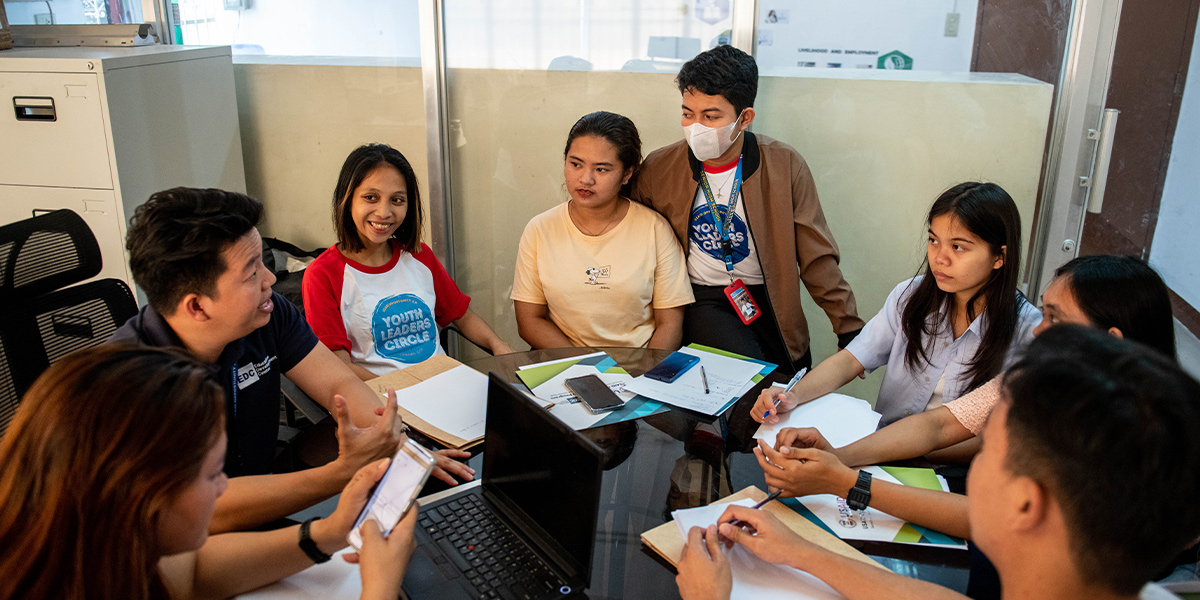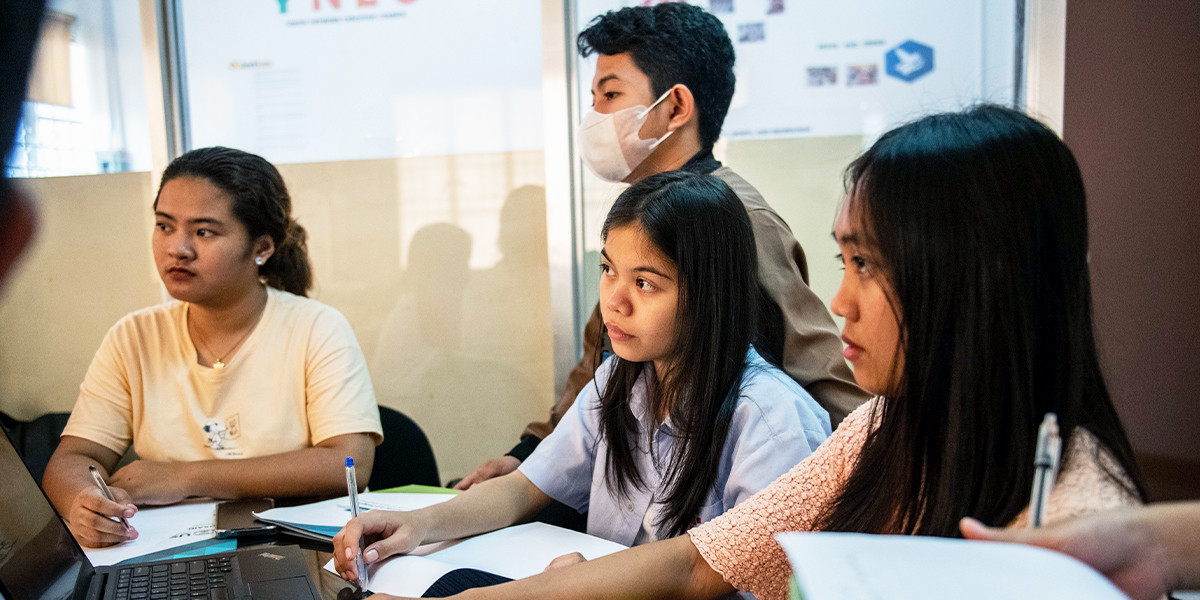The Future of Work Is Here: Part 1 – What Has Changed?

Massive shifts are transforming the future of work. With over 60 years working at the nexus of education, the world of work, and youth development, we at EDC are seeing three significant—and unprecedented—forces at play.
- A new reality is being born out of generative artificial intelligence (AI), automation, and digital transformation. Although it is too soon to tell how AI will impact the nature of work, we know that harnessing AI-driven tools at work is becoming imperative.
- Sustainability is revolutionizing our economic landscape. Companies worldwide are integrating environmental considerations into their business strategies, leading to the emergence of new job opportunities and innovative models to enhance efficiency and long-term adaptability.1
- Work is increasingly interconnected. Disruptions to how and where work is done have continued since the pandemic, resulting in marked increases in remote and short-term contract work.2
By 2030, McKinsey estimates that automation could displace 15%–30% of the global workforce, affecting 400 to 800 million workers. Workers with lower educational attainment are generally at a higher risk of job displacement due to automation, although some professions, such as clerical positions and customer service representatives, are already on the decline.3, 4, 5 According to the World Economic Forum’s Future of Jobs Report 2025, if the world’s workforce was made up of 100 people, 59 would need training by 2030.6 While millions may need to switch occupations or upgrade skills, automation and AI are also expected to boost productivity and economic growth.7
In low- and middle-income countries, the impact may be less severe, with only 0.4% of jobs at risk from generative AI compared to 5.5% in high-income countries, according to the International Labor Organization. However, the potential for AI to augment jobs is nearly equal across all countries, highlighting opportunities for growth if supportive policies are implemented.8 Employment demands will vary depending on economic contexts and the maturity of industries in each country.
Despite these opportunities, the digital divide poses a persistent challenge, with disparities in Internet access, affordability, and digital literacy. Marginalized groups, especially youth and women, remain vulnerable as they are disproportionately unemployed, underemployed, or reliant on informal work.9, 10
This disruption raises questions for policymakers, educators, and businesses: How can we prepare the workforce to adapt and thrive in these new work environments? How can lower-income countries harness these technologies as an opportunity to level up, rather than drift further behind economically and environmentally?
Despite the fears of widespread displacement and automation, data show that leaders highly value critical human skills such as project management, leadership, and adaptability that can help organizations overcome new challenges.11 This presents an opportunity for upskilling.
In Part 2 of this series, we will share findings from our research about the skills needed to navigate these transformations, and in Part 3, we will present EDC’s answers to these questions.
Nancy Chervin is an international education and workforce advisor, specializing in workforce readiness, market connections, and work-based learning. She focuses on the rapidly changing world of work through youth skills development and aligning educational institutions with employer needs.
Rachel Blum is a senior technical advisor for youth and workforce development at EDC, where she addresses development challenges at the nexus of youth employment, workforce development, and systems thinking.
1For more information, see Ellen MacArthur Foundation’s What Is a Circular Economy?: https://ellenmacarthurfoundation.org/topics/circular-economy-introduction/overview
2The World Bank estimates that 154–435 million workers are engaged in online task-based contract work. Source: Namita, D., Chen, R., Singh, S., Stinshoff, C., Iacob, N., Nigatu, N. S., Nxumalo, M., & Klimaviciute, L. (2023). Working without borders: The promise and peril of online gig work. World Bank. http://hdl.handle.net/10986/40066
3Accenture (2017). New skills now: Inclusion in the digital economy. https://www.workforceprofessionals.org/wp-content/uploads/2020/01/Accenture-New-Skills-Now-Inclusion-in-the-digital.pdf
4 World Economic Forum. (2023). These are the jobs most likely to be lost – and created – because of AI. https://www.weforum.org/stories/2023/05/jobs-lost-created-ai-gpt/
5 World Economic Forum. (2025, January). Future of jobs report 2025: Insight report. https://www.weforum.org/publications/the-future-of-jobs-report-2025/
6World Economic Forum, Future of jobs report 2025.
7McKinsey Global Institute (2024, July 16). Jobs lost, jobs gained: What the future of work will mean for jobs, skills, and wages [Updated from 2017]. https://www.mckinsey.com/featured-insights/future-of-work/jobs-lost-jobs-gained-what-the-future-of-work-will-mean-for-jobs-skills-and-wages (Note: Scroll down the webpage for the 2024 content.)
8International Labour Organization. (2023). Generative AI likely to augment rather than destroy jobs. https://www.ilo.org/resource/news/generative-ai-likely-augment-rather-destroy-jobs
9“While the global youth unemployment rate has tracked the total global unemployment rate, it remains elevated at 13%. Assessing rates of youth not in employment education or training (NEETs) highlights disparities between economies at different national income levels. While the global NEET rate remains flat at 21.7%, it stands at just 10.1% for high-income economies, rising to 17.3% for upper-middle income ones. The rate then jumps to 25.9% for lower-middle income economies and 27.6% for low-income ones.” Source: World Economic Forum. (2025, January 7). Future of jobs report 2025 (p. 8).https://www.weforum.org/publications/the-future-of-jobs-report-2025/
10 Informal employment tends to be higher among youth: 46.2% of employed youth are in the informal economy compared to 40.4% of adults. Refer to: International Labour Organization. (2018). Women and men in the informal economy: A statistical picture.https://www.ilo.org/sites/default/files/wcmsp5/groups/public/@dgreports/@dcomm/documents/publication/wcms_626831.pdf
11Coursera. (2023). L&D investment survey 2023. https://www.coursera.org/business/resources/ebook/learning-leaders-investment-survey?utm_medium=press&utm_source=pr&utm_campaign=plw-report&utm_content=pr&utm_term=plw-press







